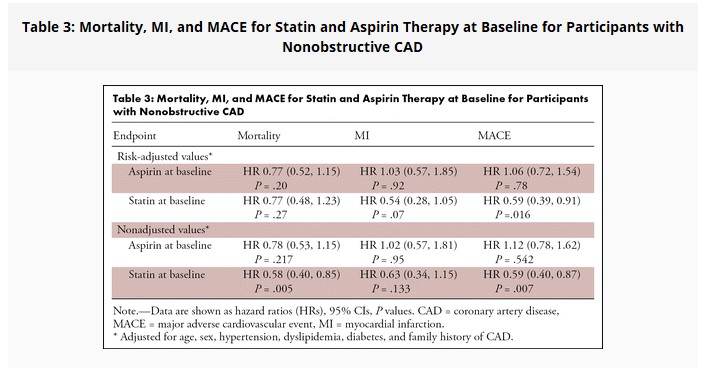They were never settled science, they were instead epidemiology, statistical correlation, which then got transformed into clinical claims, much like ivermectin and hydroxychloroquine for COVD-19.
How did that happen?
Plaque buildup in the arteries that circulate blood back to the heart is a risk factor for heart attacks, the more you have the more risk there is, so reducing that is wise, especially when nearly 7 percent of adults have it. Coronary CT angiography can detect plaque before it becomes critical, less than 50 percent blockage of the coronary arteries due to plaque, and statins are commonly prescribed because they take low-density lipoprotein (LDL) cholesterol out of plaque and prevent its build-up.
Yet avoiding a prescription appeals to many, it feels less severe, and that is where aspirin comes in.
For millenia, acetylsalicylic acid, like from a willow tree, was known to reduce swelling. It was eventually turned into aspirin and became popular due to fewer side effects in the stomach. In the early 1970s, how aspirin worked was discovered and that mechanism impacted other areas.(1) By 1988 the second International Study of Infarct Survival trial found that aspirin had a statistically significant impact on preventing repeat heart attacks and stroke. Logically, if it could prevent a second heart attack it might also prevent the first.
Epidemiologists were once so conservative they were the last to accept a link between heredity and cancer so when they agreed aspirin helped, it became a regimen to keep hearts healthier.
The problem is that, aside for looking in rows and columns of a spreadsheet and seeing what is common, it is very difficult to know if something prevented something. Confounders are everywhere. As an outrageous example, if I tell you a Magic Rock prevents Parkinson's Disease, and you take the rock and don't get the disease, you go in the 'it works' column. The problem with that is so many confounders. If I want to know if someone in their 70s avoided Parkinson's Disease with any potion, remedy, or pill, they had to start taking it decades earlier and in the trial a lot of other things would have to be controlled. That's a real challenge over time.
No one can afford clinical trials for decades and sometimes they aren't ethical - we obviously didn't do clinical trials with cigarettes and try to give half the participants lung cancer - so in those cases the only way to know is observational studies and epidemiology. It's easy to be critical of modern epidemiology because organizations like the US National Institute of Environmental Health Sciences and International Agency of Research on Cancer in France have tried to position themselves as Supreme Courts of Science - using statistical correlation to discover things that scientists miss(2) and instead scaremongering for publicity - but sometimes looking at data is the only way to know.
The new data was 6,386 patients who had undergone coronary CT angiography and were in the CONFIRM (COronary CT Angiography EvaluatioN For Clinical Outcomes: An InteRnational Multicenter) registry) with either no detectable coronary plaque or non-obstructive coronary artery disease.

Aspirin and statin use were documented for both groups and the mean follow-up period was 5.7 years. Though statin use showed a significant reduction in serious cardiovascular issues, aspirin therapy was not.
That doesn't mean aspirin can't help in some cases. Statins also did nothing for people with no plaque. It does mean that taking them may be more placeo than prevention.
NOTES:
(1) For brevity I am leaving out a lot. In 1950, Dr. Lawrence Craven published a paper hypothesizing that aspirin helped for coronary thrombosis. Sometimes knowing how it works is not as important as that it does. No physicist can really define a magnetic field, for example, without being recursive, and yet a trillion dollar semiconductor industry is built on Maxwell's Equations using E and B fields.
(2) In actuality, for the last decade both organizations have instead been on missions to find things to scare people about. The bizarre class 2b carcinogen listing IARC gave for cell phones gave unfair weight to a crackpot from Sweden, Lennart Hardell - the only positive associations they had - but still only declared it as harmful as coffee and seaweed extract. Regardless, he claims he proved it was a human "carcinogen" just the same. And did so again this week.




Comments